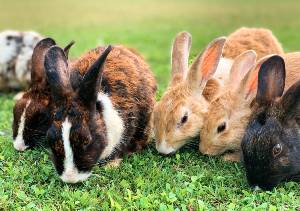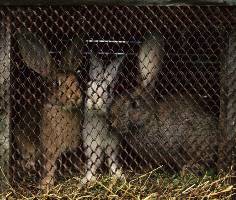
As an Amazon Associate, I might earn from qualifying purchases at no extra cost to you.
Pododermatitis in rabbits appears when a rabbit lives too long on an incorrect surface which is different from their natural environment, so they can develop irritated hocks, sometimes known as “Bumblefoot“.
Rabbits are one of the more popular companion animals, and some owners might not be aware of this problem, especially if it is their first rabbit. It is a common ailment (unfortunately). It can cause the rabbit a great deal of discomfort and pain if not treated promptly.
 The rabbit’s quality of life will decline over time. So regular checks of your rabbit’s hocks (hind limbs) are necessary to avoid the onset of this disease.
The rabbit’s quality of life will decline over time. So regular checks of your rabbit’s hocks (hind limbs) are necessary to avoid the onset of this disease.
A rabbit uses its hocks when it wants to hop around. If the hocks are hurt, it will be painful for it to launch forward and the landing, even more so, meaning a depressed bunny.
Pododermatitis is chiefly caused by hard surfaces, obesity or inadequate cleanliness where the rabbit lives. It might be due to the hutch, cage or toilet tray not being cleaned out frequently enough or cat litter as bedding instead of something more suitable for rabbits such as natural hay. The type of bedding required will depend on the breed of the rabbit so that some research will be necessary.
============================
Cat litter, wood shavings or newspaper should not be used for bedding as it is the wrong consistency for a rabbit and contains chemicals and dust. Note, rabbits eat their bedding material.
============================
==> Click here for Hay for Rabbits <==
Considering that a rabbit’s natural home is in forests, woods, meadows or sandy regions, the floor of a cage or hutch must feel very uncomfortable for them.
The metal or plastic of a cage can cause damage to the rabbit’s feet, so good bedding is continually required. The same goes for inside a hutch. These hard materials (metal/plastic) can cause heightened stress on the metatarsal bones.
Tell-tale signs
If you notice the following in your rabbit:
- inactivity
- not eating
- losing fur
- the sight of blood anywhere
– it’s time to visit the vet immediately.
Pododermatitis disease is rated from 1 to 6 in terms of gravity.
An initial consultation might reveal abscesses, swelling and inflammation on the skin of the hocks, and it is at this stage when it is treatable to prevent more severe complications.
If neglected, the problem will develop into a restriction of blood to the skin tissue, provoking a reduction of oxygen which is vital for the metabolism of cells, otherwise known as Ischemia. The painful inflammation causes the bunny to be super sensitive to touch on the surface of his hocks.
 Again, if ignored, the illness progresses onto the next more severe stage of decay of these same tissue areas. Eczema will form and although harmless, if not treated, develops into a more complicated case.
Again, if ignored, the illness progresses onto the next more severe stage of decay of these same tissue areas. Eczema will form and although harmless, if not treated, develops into a more complicated case.
Finally, a continuance of this decay leads to further scales emerging on the skin’s surface, skin erosions and ulcers.
The development of ulcers (Ulcerative Pododermatitis) will be excruciating for your poor bunny.
The ulcers will bleed, and this can often lead to bacterial infection (Staphylococcus aureus, Streptococcus and Pasteurella). Infection implies pain in the joints, bones and tendons.
Dead tissue resulting from bacterial infection, unless detected early, will be uncurable and lead to gangrene. This phase is very rare.
Furthermore, local anaemia and haemorrhages will result. A disease which starts so simple can evolve into something extremely grave and life-threatening.
============================
Fact: Did you know there are approximately 305 breeds of rabbit (Wikipedia)? However, only about 60 are recognised as domestic breeds by various worldwide pet rabbit organisations.
============================
==> Click here for Rabbit Supplies <==
Rabbit owners have to be vigilant and revise their bunny’s health frequently so early detection of this or other issues might be treated as soon as possible.
Many issues are hard to detect so regular reviews with the vet are necessary.
Pododermatitis in Rabbits (Bumblefoot)
I recommend reading about the specific care needed for these animals. For example, rabbits require particular attention when picking them up. Mishandling a rabbit can result in the rabbit going into shock and quite possibly dying. So it is imperative to learn how to do this correctly.
Your local vet will always guide you in the right direction concerning their care, potential illnesses, immunisation programs, nutrition and hygiene requirements.
Do you have a rabbit? Which breed? Do you have experience of Pododermatitis in your rabbits? I look forward to reading your comments below. Please like, comment and share with friends and family.





You have an incredible interesting website, I also am a big animal lover. I shared your article on my social media pages for my friends, family, and contacts to read as well
Jeff
Thank you Jeff!! Appreciate your support and sharing of this post. So glad you like the site. Stay safe.
Hi Susan,
I absolutely loved reading this article.
Okay, admittedly my childhood experience of rabbits were completely ruined by the extremely aggressive “Mr Dorf” (I was told he was returning to the farm to be with his mum and dad), however the less said about him the better (mental problems, started attacking humans – I’m guessing he was put down).
However, I have often heard of Bumblefoot, but I always assumed it was simply about cleanliness.
You’ve certainly opened my eyes and it seems as though this could indeed be extremely horrific for poor bunny.
Thank you for a thoroughly enjoyable read and you’ve certainly brought back some great childhood memories.
Partha
Partha, thank you! So sorry to hear what you experienced with “Mr Dorf” (poor thing!). Yes, for something that sounds quite innocent, Bumblefoot can indeed turn into something quite worse. Thanks for reading and sharing.
I have to admit, I’ve only had one rabbit and he pooped everywhere, so it was very short lived. I had a friend as a teen say she’d take care of him for me and that was the end of my rabbit days.
I know a lot of people with rabbits as pets though, and I’m sure they’ll love this information.
Definitely sharing this with them.
Thank you for the great information!
Hi Katrina. Oh, so lucky you could hand him over to your friend. Many rabbits, unfortunately, find themselves in refuge shelters hoping to be adopted. I guess you still got to see him occasionally. Yes, rabbits are very popular as pets. I´m glad you found this post about pododermatitis/bumblefoot interesting. Thank you for sharing and for your comments.
I absolutely loved reading this post. You have an amazing website devoted to animals for those who visit your website and read about the fantastic posts. The only thing I remembered after reading this is bugs bunny which took me back to my childhood. Thank you for bringing back that beautiful era into my life.
ahhh thanks Habib. Very pleased you like the site. Glad I could bring back memories of Bugs Bunny for you. I bet he didn´t have pododermatitis!